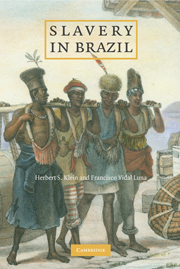8 - Family, Kinship, and Community
Published online by Cambridge University Press: 05 June 2012
Summary
Flight, rebellion, resistance, and violence could not be the only responses possible to slavery in Brazil. The majority of Africans and their descendants tried to survive the slave experience and create as normal a life as possible in the context of this harsh regime. Thus, family and community were a fundamental part of the Afro-Brazilian experience and in turn helped to mold and define the larger society outside of slavery as well. Forced to work for others and with little control over their lives, slaves began to learn skills, form families, and create kin and friendship networks that would survive the institution of slavery. They also found solace and community in their religion and brotherhoods.
Although they spoke a multitude of different languages and came from different cultural systems and nationalities, the African slaves arriving to Brazil sometimes shared a number of commonalties that may have helped bind them together in the New World. The opening up of Atlantic trade, for instance, contributed to the development of interregional contacts within Africa by creating ever-larger market areas. Meanwhile, the fairly constant expansion and reorganization of African states and societies over time brought many different groups into contact. Although the process of cultural integration on the African continent should not be overemphasized, neither should the diversity of Africa be exaggerated. Not every ethno-linguistic group comprised a distinct culture that was totally different from others.
- Type
- Chapter
- Information
- Slavery in Brazil , pp. 212 - 249Publisher: Cambridge University PressPrint publication year: 2009



